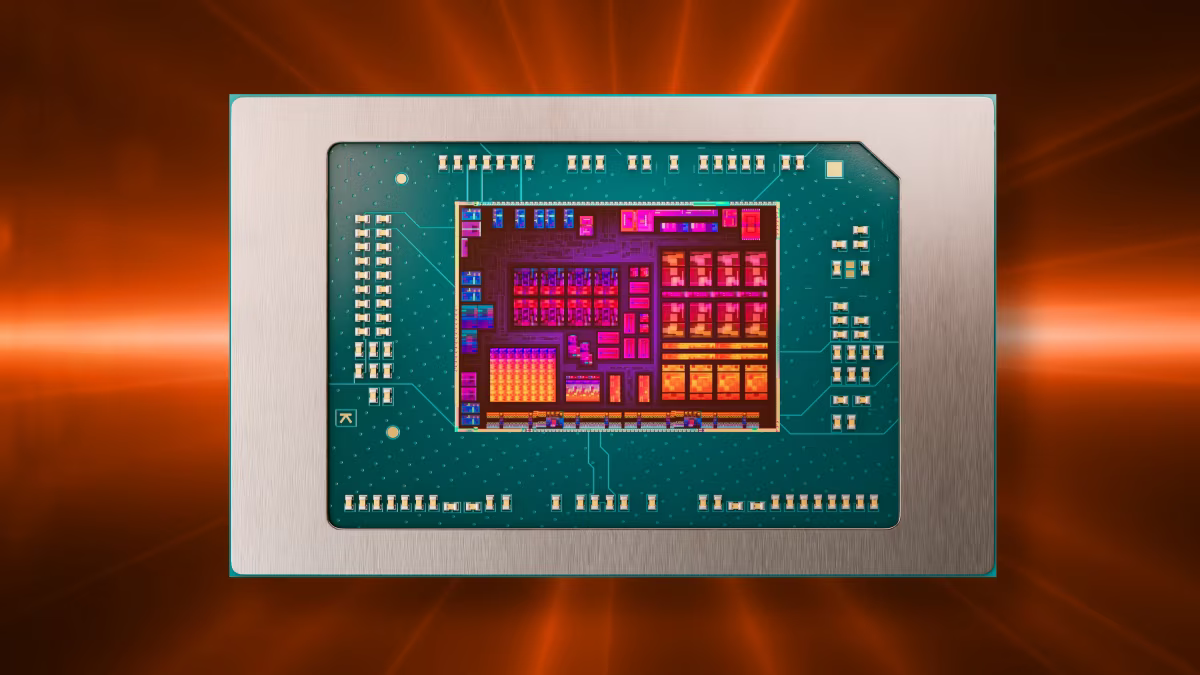AMD quietly announces Ryzen 8000HX series — Dragon Range Refresh arrives to replace AMD's top laptop CPUs
Some 100 MHz boosts seem to be the only difference over OG Dragon Range.

AMD has officially announced its Ryzen 8000HX Series of mobile CPUs today, intended for gaming and other high-end applications. Codenamed Dragon Range Refresh, the chips serve as a refresh of AMD's Ryzen 7000HX family, AMD's highest-performance laptop CPU line that has been in production since mid-2023.
Coming in four unique SKUs, all aiming for high-end performance, the Ryzen 8000HX series comes in up to 16 cores and 32 threads, clocked at up to 5.4 GHz. The chips come with up to 80MB of total cache and are paired with Radeon 610M onboard graphics, a two-core graphics solution meant to be supplanted by a dedicated GPU.
Model | Cores / Threads | Boost / Base Frequency (GHz) | Total Cache | Graphics Model | Configurable TDP |
Ryzen 9 8945HX | 16 / 32 | 5.4 / 2.5 | 80MB | Radeon 610M | 55-75W |
Ryzen 9 8940HX | 16 / 32 | 5.3 / 2.4 | 80MB | Radeon 610M | 55-75W |
Ryzen 7 8840HX | 12 / 24 | 5.1 / 2.9 | 76MB | Radeon 610M | 45-75W |
Ryzen 7 8745HX | 8 / 16 | 5.1 / 3.6 | 40MB | Radeon 610M | 45-75W |
Dragon Range Refresh was leaked several times by AMD partners before its announcement today, with MSI and Asus prematurely announcing the chips in their new products several times since January. Originally expected to be announced at CES 2025, the Ryzen 9 8940HX was prematurely leaked in a listing for the ROG Strix G16 2025 yesterday, confirming its stats and speeds.
As a refresh of the Dragon Range 7000HX series, the 8000HX doesn't offer anything consumers haven't seen before, besides a refined polish on a successful laptop CPU family. Built on the 5nm node, Dragon Range Refresh uses AMD's Zen 4 architecture to bring chiplet tech to high-end gaming laptops. Reviews of the 7000HX series found it to be a fierce competitor against lacking Intel competition, and the 8000HX is expected to be a continuation of the same impressive run.
The refresh doesn't seem to provide consumers with any serious boosts or differences in performance over Dragon Range's first go-around, as can be seen in the chart below. The only change visible from these basic speeds and feeds is a 100 MHz increase in boost clock to the Ryzen 9 8940HX from the 7940HX.
Model | Cores / Threads | Boost / Base Frequency (GHz) | Total Cache | Graphics Model | Configurable TDP |
Ryzen 9 8945HX | 16 / 32 | 5.4 / 2.5 | 80MB | Radeon 610M | 55-75W |
Ryzen 9 7945HX | 16 / 32 | 5.4 / 2.5 | 80MB | Radeon 610M | 55-75W+ |
Ryzen 9 8940HX | 16 / 32 | 5.3 / 2.4 | 80MB | Radeon 610M | 55-75W |
Ryzen 9 7940HX | 16 / 32 | 5.2 / 2.4 | 80MB | Radeon 610M | 55-75W+ |
Ryzen 7 8840HX | 12 / 24 | 5.1 / 2.9 | 76MB | Radeon 610M | 45-75W |
Ryzen 7 7840HX | 12 / 24 | 5.1 / 2.9 | 76MB | Radeon 610M | 45-75W |
Ryzen 7 8745HX | 8 / 16 | 5.1 / 3.6 | 40MB | Radeon 610M | 45-75W |
Ryzen 7 7745HX | 8 / 16 | 5.1 / 3.6 | 40MB | Radeon 610M | 45-75W |
Part of Dragon Range Refresh seems to be consolidation. Where the Ryzen 7000HX series offered 7 SKUs, the refresh cuts this down to 4. We will be interested to see if 8000HX ever offers an X3D model like the Ryzen 9 7945HX3D, but for now it does not seem like the case.
The refresh was also carried out with relatively little fanfare; where Intel's lackluster 2024 Raptor Lake Refresh was highly advertised and marketed, Dragon Range Refresh was heralded by a simple, graphic-less press release and a few new product pages on the AMD website. Clearly, the 8000 HX series is not seeking to be a bold new step for AMD, but a simple sidegrade, likely at some cost advantage thanks to reusing old wafer designs.
Get Tom's Hardware's best news and in-depth reviews, straight to your inbox.
Major laptop brands will likely begin offering laptops containing the Ryzen 8000HX series soon. We already know from their leaks that MSI and Asus will be among the first to bring Ryzen 9 8940HX to market. Those looking for the best in laptop performance will likely seek out 8000HX, but those not needing the best and brightest can turn to now-last-gen 7000HX machines as long as they hang around.

Sunny Grimm is a contributing writer for Tom's Hardware. He has been building and breaking computers since 2017, serving as the resident youngster at Tom's. From APUs to RGB, Sunny has a handle on all the latest tech news.
-
DS426 DRR is meant to be a lower-cost alternative to Fire Range? I say that as FR is expected in 2025H1, which would mean in roughly the next 50 days if it stays on track.Reply -
thestryker Reply
While I'm sure they will likely be lower cost there are also more SKUs. The launch lineup of Fire Range is only two dual CCD models and one X3D dual CCD. This should allow them to wait longer before offering other SKUs (if they even do at all prior to Zen 6).DS426 said:DRR is meant to be a lower-cost alternative to Fire Range? -
thestryker Reply
These are just desktop CPUs binned and packaged for mobile like Intel's HX line.sjkpublic said:GPU Radeon 610M? Is that a misprint? Why not 780M or higher? -
HideOut So from what I see here, this is basically the same CPU as the last gen but plus 100 MHz correctReply -
Pemalite AMD's mobile lineup is a mess in my opinion.Reply
Zen 2 and RDNA 2.
Zen 3+ and RDNA 2.
Zen 4 and RDNA 3.
Zen 4 and RDNA 2.
Zen 5 and RDNA 3.5.
Zen 5 and RDNA 2.
And many share the same "series" of model numbers.
This is just a boring rebadge launch to appease OEM's it seems as they like new CPU's to advertise every year. -
thestryker Reply
It's exactly the same hardware with higher clocks whether that comes from better bins or voltage control only AMD could say.HideOut said:So from what I see here, this is basically the same CPU as the last gen but plus 100 MHz correct -
DS426 Reply
Kind of standard in the business world. Take automobiles for example: a new model year but not a new generation or mid-cycle refresh means maybe new paint options, wheels, and probably not much more. They could have just offered those things in the first place, but new year, new models, new earnings potential! Let's also remember that big blue created the precedence for this practice.Amdlova said:This is the AMD way to milking the consumer no real change but the price always UP!
Coming from more of an enterprise angle, it might actually mean extending support as typically support has a fixed, known-quantity end date from the time a product is released; therefore, even a CPU refresh with the only difference of +100 MHz clocks being that vendor support is pushed out again by that fixed length. This theory of mine extends to explain going back to when AMD introduced that crazy five-ring decoder wheel: https://hothardware.com/news/decode-amds-new-naming-schemes-mobile-ryzen-processors
Indeed, as commented on earlier, this means that architectures as old as Zen 2 and RDNA 2 are still being supported and will be for years to come. At least the older Zens are still benefiting from CPU stepping. :/ -
DS426 Replysjkpublic said:GPU Radeon 610M? Is that a misprint? Why not 780M or higher?
Yep, and the article mentioned this: that these CPUs are intended to be used in conjunction with discrete graphics. On the other hand, anyone that wants both a powerful laptop CPU and powerful iGPU has Strix Halo.thestryker said:These are just desktop CPUs binned and packaged for mobile like Intel's HX line.